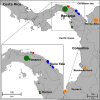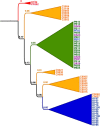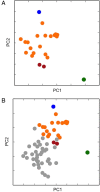Clonal outbreak of Plasmodium falciparum infection in eastern Panama
- PMID: 25336725
- PMCID: PMC4366603
- DOI: 10.1093/infdis/jiu575
Clonal outbreak of Plasmodium falciparum infection in eastern Panama
Abstract
Identifying the source of resurgent parasites is paramount to a strategic, successful intervention for malaria elimination. Although the malaria incidence in Panama is low, a recent outbreak resulted in a 6-fold increase in reported cases. We hypothesized that parasites sampled from this epidemic might be related and exhibit a clonal population structure. We tested the genetic relatedness of parasites, using informative single-nucleotide polymorphisms and drug resistance loci. We found that parasites were clustered into 3 clonal subpopulations and were related to parasites from Colombia. Two clusters of Panamanian parasites shared identical drug resistance haplotypes, and all clusters shared a chloroquine-resistance genotype matching the pfcrt haplotype of Colombian origin. Our findings suggest these resurgent parasite populations are highly clonal and that the high clonality likely resulted from epidemic expansion of imported or vestigial cases. Malaria outbreak investigations that use genetic tools can illuminate potential sources of epidemic malaria and guide strategies to prevent further resurgence in areas where malaria has been eliminated.
Keywords: Plasmodium falciparum; drug resistance; molecular surveillance; outbreak, epidemic; tropical diseases.
© The Author 2014. Published by Oxford University Press on behalf of the Infectious Diseases Society of America. All rights reserved. For Permissions, please e-mail: journals.permissions@oup.com.
Figures





References
-
- Calzada JE, Samudio F, Bayard V, Obaldia N, de Mosca IB, Pascale JM. Revising antimalarial drug policy in Central America: experience in Panama. Trans R Soc Trop Med Hyg. 2008;102:694–8. - PubMed
-
- Samudio F, Santamaria AM, Obaldia N, III, Pascale JM, Bayard V, Calzada JE. Prevalence of Plasmodium falciparum mutations associated with antimalarial drug resistance during an epidemic in kuna yala, Panama, Central America. Am J Trop Med Hyg. 2005;73:839–41. - PubMed
-
- Anderson TJ, Haubold B, Williams JT, et al. Microsatellite markers reveal a spectrum of population structures in the malaria parasite Plasmodium falciparum. Mol Biol Evol. 2000;17:1467–82. - PubMed
-
- Volkman SK, Neafsey DE, Schaffner SF, Park DJ, Wirth DF. Harnessing genomics and genome biology to understand malaria biology. Nat Rev Genet. 2012;13:315–28. - PubMed
Publication types
MeSH terms
Substances
Grants and funding
LinkOut - more resources
Full Text Sources
Other Literature Sources

